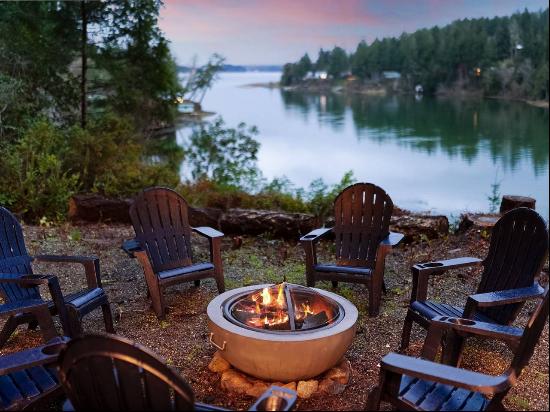
By Susie Mesure
Few American homes are known for their history in the same way as many of their European counterparts. But the solid white mansion tucked away in a corner of Bainbridge Island, a ferry hop from Seattle, Washington, would challenge anywhere for an exciting back story.
The property, which is now an elegant four-bedroom family home and is on the market for $7.6m, was at the heart of the US Navy’s intelligence operations during the second world war. Known then as Building 39, it was built in 1941 as part of Naval Radio Station Bainbridge. The station was home to machines that attempted to decrypt messages from the Imperial Japanese Navy, including those that preceded the attack on Pearl Harbor in December of that year, which prompted America to join the war.

“It was considered the ears and the brain of the US Navy’s decryption centre,” says Shawn O’Neill, who moved here from southern California 18 years ago with his wife, Bethany, who was pregnant at the time. “Messages were sent on to Washington DC for final decoding.” Although no one is thought to have lived at the property during the war, there would have been enough work space for 100 personnel, adds Shawn.
The house, which is made of poured concrete, spans 12,000 sq ft over three floors and sits in 10 acres of land. It was abandoned for decades before being converted into a luxury family residence in the 1980s. “It was a rough-and-tumble concrete structure. A lot of the teenagers on the island used to come here and do whatever teenagers do,” says Shawn.
The O’Neills, who paid $2.3m for the property and are its third private owners, liked the scale of the building, which combines Art Deco-inspired features added by the first owner with Palladian-style symmetry and columns. “It felt to me like a European residence. I was awestruck by it. It’s a big, heavy structure but it’s open and sunny and feels very light,” says Bethany.

The previous owners had extended the original 10,000 sq ft footprint with an indoor pool and two separate garages for up to five cars, leaving the O’Neills to concentrate on updating the interiors. They added wooden flooring and brass fittings, while soffits in several rooms were removed to reveal original concrete beams, now painted white. All five bathrooms and the kitchen were remodelled.
“There was a concrete cavity in the centre of the house that was once the Navy’s vault. It is now exposed concrete and forms one side of the bar,” says Bethany. The O’Neills decided to respect the building’s austere exterior. “We toyed with adding shutters or ornamentation to the front facade but felt the ghost of the US Navy would say, ‘No shutters; this is a military building. Let’s make sure this building is loud and proud and it's for eternity,’” says Shawn.
With walls of two-feet thick concrete — built to withstand a potential air attack — the greatest challenges were installing wiring and adding modern technology, says Shawn, who works in private client banking. He used to commute to Seattle on the 35-minute ferry, which leaves from downtown Bainbridge Island, a 15-minute drive away, but has been based at home during the pandemic.

Outside, the house is ringed by densely packed mature trees, including hawthorns, flowering pears, cedars and Douglas firs. “I always say, I feel like I'm looking at a landscape painting by Turner. Each window beautifully frames the trees,” says Bethany, whose favourite season here is autumn, partly because lots of deer wander the grounds.
After years of throwing elaborate fundraisers for up to 200 people for various charities, the O’Neills, who have four children, want to downsize. “We’ve done our fair share of entertaining and are ready to pass the baton to another family,” says Shawn. “But we’ll stay on the island; we’re not quite ready for a condo.”
Photography: Clarity Northwest/Christie’s International Real Estate




















